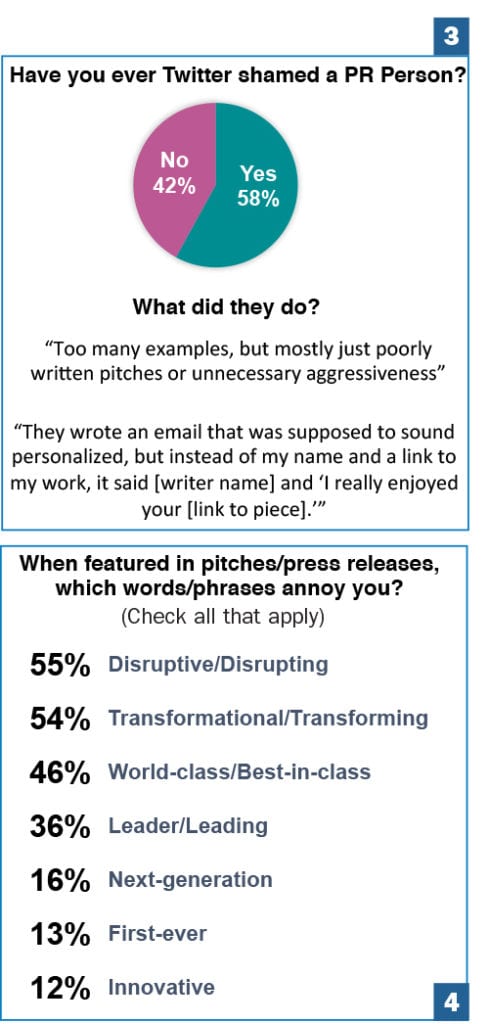
Every PR pro has heard a variation on the statistic about there being far more communicators than reporters. The most recent news peg reporters used to cover this dismal (for reporters) item was the poor prognosis for newspapers from Warren Buffett. The billionaire investor said in a late-April interview with Yahoo that he’s unenthusiastic about the future of most newspapers. The decline in ad revenue has made the majority of newspapers “toast,” he said.
More PR Jobs
From there reporters at Bloomberg mentioned Census Bureau statistics saying PR pros outnumber journalists by more than 6 to 1, up from 2 to 1 two decades ago.
Social media will result in even more PR jobs. The Labor Department predicted April 12 communications gigs will rise to 282,600 in 2026, up 9 percent from 2016. News jobs, though, are forecast to fall 9 percent to 45,900 over the same period.
Added to these predictions is the anecdotal evidence that the one reporter in the 6:1 ratio is doing the job of two or three. (Let’s not even discuss the gap in salary between PR pros and journalists.)
This unbalanced ratio is leading some communicators to incorporate more owned content and other non-earned-media tactics into their strategies. [We’ll explore this next month.]
On the other hand, many companies and organizations still want at least some earned media. And, yes, so many executives believe the earned media universe starts and ends with a mention in the NY Times and/or Wall St Journal.
Certainly we urge you to provide informed counsel to executives as to why that’s not a sound media strategy (and use the article from Zeno Group EVP Michael Brito from our April edition as ammunition). Still, much of the PR pro’s job remains getting mentions in major media (see Frederik Bjørndal’s article in our Dec. 2018 edition for tips on major media placement). [Ed Note: All articles are available to subscribers in our Subscriber Resources Center.]

An Important Ratio
The ratio of communicators to reporters mentioned above is relevant. With so many PR pros chasing a dwindling number of reporters, it’s almost inconceivable that media do not, at times, feel overwhelmed. Add to this uneven numerical situation the fact that so many PR pros still pitch and pray, sending the same (often off-target pitch) to hundreds of reporters with the click of a mouse. Some news releases aren’t merely errant pitches; they actually lack discernable news content. This helps make the annoyance factor considerable.
It’s little surprise then that PR pros can come off as annoying, wasters of journalists’ time and someone to be avoided. Perhaps this has spawned the practice of journalists engaging in the Twitter shaming of PR pros.
The larger question is how can PR pros stand out from the media-pitching crowd? To answer this we asked Clarity PR to survey journalists late last month about pitching preferences and pet peeves. How many email pitches do they open? Why do they elect to consider some pitches and ignore others? What motivates a journalist to consider a pitch? Are there words or phrases in pitches that raise red flags? Clarity even asked about Twitter shaming.
The response on Twitter shaming from the 100 journalists in the survey was a bit alarming. Nearly 60 percent said yes, they’d Twitter-shamed a journalist (see chart 3). One journalist said shaming a PR pro was the result of poorly written pitches and coming off as being too aggressive.

VP, BGR PR
Another shamed a communicator who pretended to know the journalist and sent a bogus personalized pitch. Fortunately, several journalists said they eschewed the practice of shaming PR pros in public.
For Frank Ahrens, VP at BGR PRin Washington, D.C., “Journalists are doing PR pros a favor by Twitter shaming. They’re rightly--if not gently or decorously--telling us to up our game,” he says.
The former VP, global corporate communications at Hyundai Motor, is the author of a recent prnrewsonline.com article on Twitter shaming. PR pros who don’t want to be Twitter shamed, he says, “spell names and organizations correctly,” are respectful and brief. “They offer actual news and don’t pitch reporters on topics not on their beats.” They avoid sending emails starting with, ‘Dear XXXX’ and don’t affect a faux-chummy tone if they don’t know the reporter.”
Good News: An Opening
Perhaps the biggest surprise from the survey was that journalists still seem to depend on pitches. They open nearly two-thirds of the email pitches and press releases they receive (63 percent), the survey says (please see chart 1).
Phoning It In
A whopping 82 percent of journalists say they’ll answer the phone if they suspect a PR pro is calling (please see chart 2).
Late last year PRNEWS and partner PublicRelay held a Communications Leaders Roundtable (see our Feb. 2019 edition) where the importance of building relationships with media was emphasized. Consensus was that an often-overlooked tool in the digital era is the telephone.

“‘Pick up the horn,’” is the advice a senior communicator said her mother, a PR pro decades ago, repeats constantly. Another said, “I tell my young staffers it’s not enough to email” journalists, “you need to call them.” Added another, “I don’t know how else you build trust” with journalists and “offer nuance.”
Adds pitching guru and frequent PRNEWS contributor Michael Smart, principal of SmartPR, “The phone is your secret weapon. PR pros read Twitter rants about journalists hating phone calls and are scared to use the phone. But you carefully and authentically create digital touchpoints with targeted journalists, and then find an appropriate time to reach out. And then you enjoy a relationship that endures.”

Opening the Pitch

SVP, BCW
Still, email pitches predominate. So, how can communicators prime the pump and increase the chance that their email pitches and press releases are opened? The formula includes a mix of the basics and a few surprises.
The top vote getter from the journalists is hardly a surprise. 46 percent respond to a pitch when it’s from a company “I cover” (see chart 5). This emphasizes the importance of pitching the correct journalists, of course.
For Nati Katz, SVP/senior director at BCW, it goes beyond that. “This,” he says, “is the turning-point element every PR person should put in front of themselves: ‘How do I get the company I represent to be of interest to a reporter, as opposed to a one-time transaction?’ The PR pro’s mindset should be: ‘How do I relay to media a sense of ‘You can’t afford to miss this?’”
Personal Pitch
Next on the list came two predictable elements, the email pitch “is obviously personalized” (44 percent) and “I know the sender” (39 percent).
Following the money continues to motivate journalists. 31 percent said a dollar figure in a pitch or press release would influence them to open a pitch and peruse it.
A brand’s name-recognition counts too. When the pitch or release contains an iconic brand it motivates 21 percent of journalists to open the email, the survey says.

Creativity Overrated?
For those who spend a lot of time devising counter-intuitive and clever pitches, the numbers weren’t great. Creativity motivates just 17 percent of journalists to consider your story, the survey says.
Katz, though, takes issue with this finding. “Creativity [in pitching] isn’t going away,” he says, but a creative pitch might not seem so on first glance. “Creativity makes an impact in today’s pitches around the question of ‘Why?’ and ‘Why now?’ and ultimately, ‘Why pitch to you?’”
To reach that level of creativity, Katz is a strong advocate of excessive reading. “The more information, sources, and multi-topic areas you expose yourself to, the more likely your mind will start connecting those dots and reaching new ‘whys’ that are of unique interest to reporters,” he says. “Technology, economics, policy, consumer preferences, demographics and world events; they can all be connected in ways that matter to journalists and can help journalists differentiate their story, a goal they have almost daily.”
Bad Writing Hurts…

VP, Clarity
What gets a pitch or press release tossed? The reasons are more subjective than why a pitch is opened, “but there are definitely some best practices to be gleaned,” says Sherry Smith, VP, media, mobile & marketing at Clarity, U.S. The most commonly-selected reasons are all, at least in part, related to how you assemble your pitch, she adds.
The survey assumes that a pitch or release outside the journalist’s beat immediately gets it a trip to the trashcan. As such, badly aimed pitches weren’t included in the survey.
Some of the common wisdom around journalists is that they hate bad and unclear writing in pitches and press releases. They’re also supposed to detest jargon and hyperbole. The survey confirms this.
As Does Jargon...
The sin of “too much jargon or hyperbole” keeps 25 percent of journalists from opening a pitch or reading a press release. “I can’t tell where the news is” deters 33 percent. Together these responses encompass bad writing, gathering nearly 60 percent of the respondents.
Smith notes, though, removing jargon and hyperbole is done easily. Yet she admits sometime there are issues.
For example, some organizations insist their press releases refer to them as “the leading authority...” or “the leader in the field...”
“If you and everyone else says they’re the leader, then leader has no meaning,” she says. The exception, of course, is if you can quantify the measure of your leadership.
…And a Lack of Authenticity
While bad writing motivates almost 60 percent of journalists to ditch a pitch, it’s not quite the 71 percent who’ll toss a pitch if the communicator pretends to know the journalist, but doesn’t. Authenticity remains the coin of the realm.
It’s not difficult to assume this pet peeve is related in some way to privacy concerns at a time when digital technology makes compromising one’s personal data relatively easy.
It might also attest to the importance of real relationships between media and PR pros. For example, 56 percent of those surveyed said if they “had no experience with the sender/or a bad previous experience” with the pitcher, they’d toss the pitch.
“A top-tier journalist told me he believes that PR pros use software that scans the web and mail-merges the headline of his most recent article into mass emails,” adds pitching pro Smart. “I’ve had an agency executive admit that they type in ‘re:’ in the subject line of a cold outreach to trick journalists into thinking they’ve already had a dialogue.”
Says Smart, “How can you establish a relationship of trust if it’s founded on subterfuge?” A proponent of ‘less is more’ when pitching, Smart says, “The time you invest in researching a limited number of crucial contacts is returned to you tenfold in increased coverage of higher quality.”
Words to Avoid
Speaking of bad writing, Clarity also asked the journos about words that annoyed them in pitches and releases. Since a large percentage of the journalists who responded to the survey write about technology and other tech-related and financial subjects, it’s not surprising they dislike seeing words such as “disruptive/disrupting” (55 percent), “transformational/transforming” (54 percent) and “world-class/best in class” (46 percent).
As mentioned above, overuse of the words “leader” and “leading” is a pet peeve of journalists. As such, those words garnered a healthy 36 percent of disapproval from journalists in the survey.
“So many of these terms are overused to the point that they’re more than just meaningless, they’re downright annoying,” Smith says. A solution, she says, is to illustrate the “disruption,” or why your company or its products are “innovative” or “transformational.” Use real examples or reasons why you believe that to be true. “If you can’t express the rationale behind the claim, then don’t make the claim.”
Looking at the survey and the state of media relations, Ahrens says, “It’s pretty simple, really: Offer something timely, of value, to the right journalist with respect. And don’t annoy them.”
CONTACT: [email protected] [email protected] [email protected] [email protected]
